
Siri Sande (born 27 September 1943) is a Professor Emerita of Archaeology. She specialises in Roman material culture, specifically late antique culture and visual art.

Siri Sande (born 27 September 1943) is a Professor Emerita of Archaeology. She specialises in Roman material culture, specifically late antique culture and visual art.
Sande studied classical archaeology, art history, and classical languages at the University of Oslo. In 1972, the University of Oslo awarded her an MA in classical archaeology in 1972. Her MA dissertation focused on Roman portraits in the sixth century CE. [1]
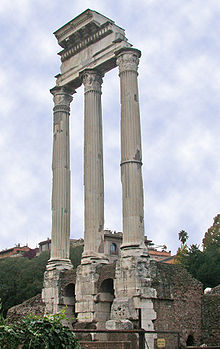
From 1975, Sande was assistant professor in classical archaeology at the University of Oslo, and was Professor from 1996. Sande contributed to the excavation of the Temple to Castor and Pollux in the Roman Forum in Rome, 1983–9. [2] She was deputy director of the Norwegian Institute in Rome 1983–1990. She became Director of the Institute 2003–07. [1]
Sande is the daughter of the writer Jakob Sande (1906–1967).

Castor and Pollux are twin half-brothers in Greek and Roman mythology, known together as the Dioscuri or Dioskouroi.
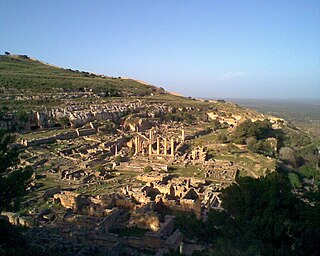
Cyrene or Kyrene was an ancient Greek and later Roman city near present-day Shahhat, Libya. It was the most important of the five Greek cities in the region, known as the pentapolis. It gave eastern Libya the classical name Cyrenaica, which it has retained to modern times.

Apollodorus of Damascus was an architect and engineer from Roman Syria, who flourished during the 2nd century AD. As an engineer he authored several technical treatises, and his massive architectural output gained him immense popularity during his time. He is one of the few architects whose name survives from antiquity, and is credited with introducing several Eastern innovations to the Roman Imperial style, such as making the dome a standard.
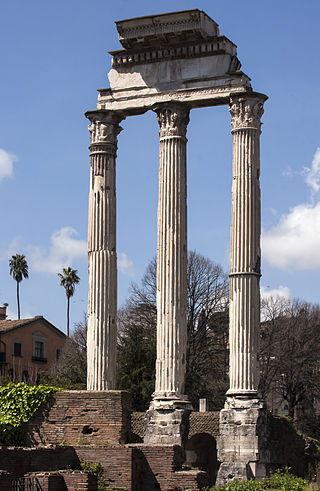
The Temple of Castor and Pollux is an ancient temple in the Roman Forum, Rome, Central Italy. It was originally built in gratitude for victory at the Battle of Lake Regillus. Castor and Pollux were the Dioscuri, the "twins" of Gemini, the twin sons of Zeus (Jupiter) and Leda. Their cult came to Rome from Greece via Magna Graecia and the Greek culture of Southern Italy.
Giovanni Becatti was an Italian Classical art historian and archaeologist.

The Arch of Augustus was the triumphal arch of Augustus, located in the Roman Forum. It spanned the Via Sacra, between the Temple of Castor and Pollux and the Temple of Caesar, near the Temple of Vesta, closing off the eastern end of the Forum. It can be regarded as the first permanent three-bayed arch ever built in Rome.
Larissa Bonfante was an Italian-American classicist, Professor of Classics emerita at New York University and an authority on Etruscan language and culture.
Nancy Thomson de Grummond is the M. Lynette Thompson Professor of Classics and Distinguished Research Professor at Florida State University. She specializes in Etruscan, Hellenistic and Roman archaeology. She serves as the director of archaeological excavations at Cetamura del Chianti in Tuscany, Italy. Her current research relates to Etruscan and Roman religion, myth and iconography.
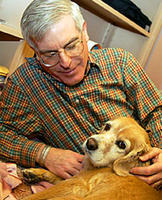
David Soren is an American archaeologist and former vaudeville performer.

Fortuna Huiusce Diei was an aspect of the goddess Fortuna, known primarily for her temple in the Area Sacra di Largo Argentina at Rome. Cicero lists her among the deities who should be cultivated in his ideal state, because "she empowers each day". She thus embodies an important aspect of time as it figures in Roman religion: every day of the year had a distinct and potent nature, which the public priests were responsible for knowing and aligning the community with by means of the religious calendar.

Leda and the Swan is an oil painting by Peter Paul Rubens, who painted two versions of this subject. The first was completed in 1601 and the second in 1602.
Giuseppe Zecchini is an Italian historian.
Francesca Romana Serra Ridgway was a leading twentieth century scholar of Etruscan and Italic archaeology.
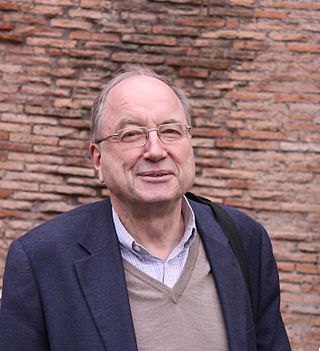
Henner von Hesberg is a German classical archaeologist.
P. Gregory Warden is an American archaeologist, President and Professor of archaeology at Franklin University Switzerland, and expert on Etruscan art, archaeology, and ritual, Roman architecture and Greek archaeology. He is the inaugural Mark A. Roglán Director of the Custard Institute for Spanish Art and Culture at Southern Methodist University.

Raissa Samojlovna Calza was a Ukrainian dancer who became a prominent classical archaeologist of Roman portraiture. When she was young, she fled to Italy and France following the Russian Revolution.

Maria Floriani Squarciapino (1917-2003) was an Italian classical archaeologist and professor at La Sapienza University in Rome, known for her work on the Roman port city of Ostia.
Lea Margaret Stirling is a Canadian classical scholar and professor in the Department of Classics at the University of Manitoba. Her research focuses on Roman archaeology and Roman art with particular emphases on Roman sculpture, Late Antique art, and cemetery archaeology, and Roman North Africa.
Ann Olga Koloski-Ostrow is an American archaeologist known for her studies of hydraulic engineering in the ancient world. She works at Brandeis University as a professor of classical studies, the Kevy and Hortense Kaiserman Endowed Chair in the Humanities, and co-director of graduate studies in Ancient Greek and Roman Studies.
Lucia Guerrini (1921–1990) was an Italian classical scholar, archaeologist and professor. After participating in the Phaistos excavations in Crete in 1957, she became an enthusiastic editor of the Enciclopedia dell'arte antica, classica e orientale under the auspices of Ranuccio Bianchi Bandinelli. From the 1950s, she taught Greek and Roman Art at the Sapienza University of Rome, succeeding Bandinelli as Professor of Archaeology and Greek and Roman Art in 1973. Guerrini participated in projects relating to Greek and Roman iconography, Coptic art and the Antinoöpolis excavations in Egypt.